#Christopher Latham Sholes
Text

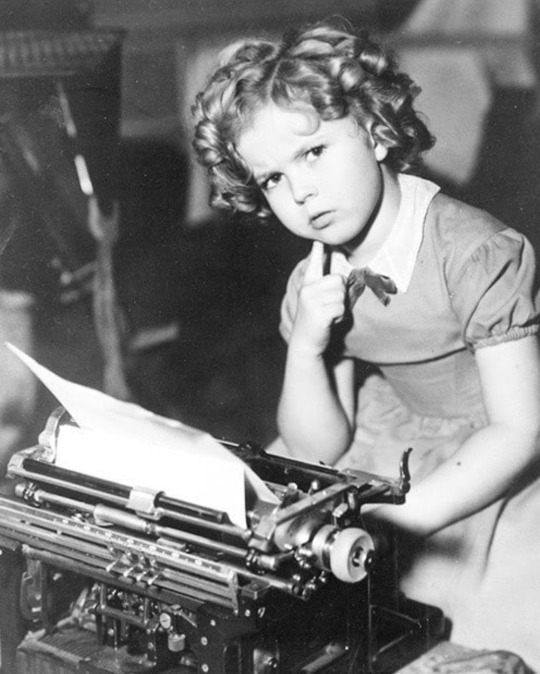
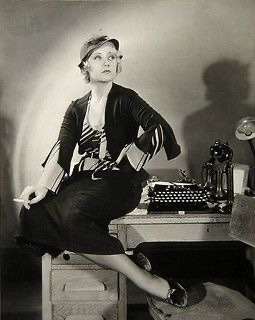

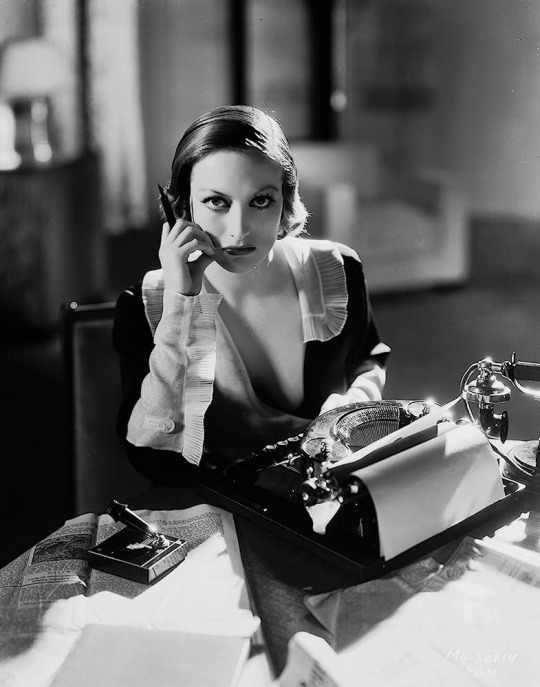
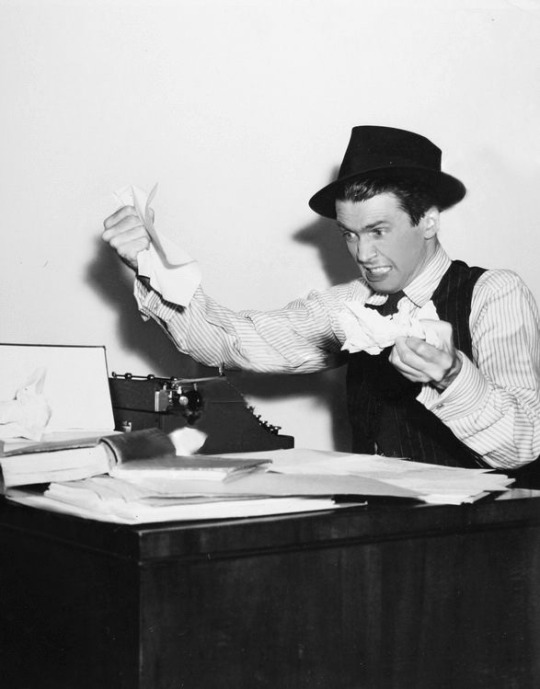
June 23, 1868: today is #NationalTypewriterDay to commemorate the anniversary of the granting of a patent to American inventor Christopher Latham Sholes.
24 notes
·
View notes
Text
MAKING THINGS EASIER
Evolución de la interfaz gráfica de usuario
Hoy en día los ordenadores son omnipresentes, no podemos escapar de ellos. Vivimos en una época apasionante de diseño e interfaces de usuario en constante evolución, una nueva era tecnológica.
La creación de un hardware…

La revolución industrial hizo hincapié en la productividad. Durante "la era de las máquinas", construimos objetos a gran escala para facilitarnos la vida. Era una época en la que el propio hardware seguía siendo la principal "interfaz de usuario". Por ejemplo la invención de la máquina de escribir en 1868 por Christopher Latham Sholes.
Empezamos a pulsar teclas físicas para crear palabras, todavía usando nuestras manos, pero con la ayuda de la máquina de escribir como reemplazo de la pluma. Ahorraba tiempo y ayudaba a crear un formato coherente y práctico que podía adoptarse rápidamente.
El hardware como interfaz había llegado, sin embargo, había un inconveniente: aprender a escribir a máquina antes de poder utilizarlo.
La era del software...
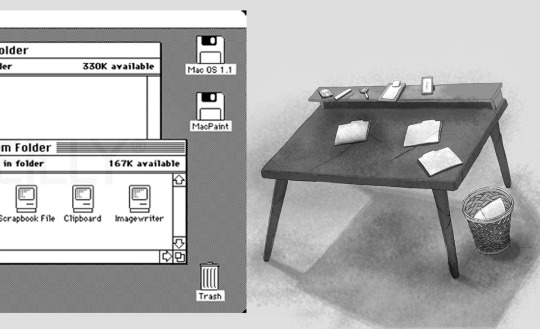
El software necesitaba una "interfaz de usuario" y, en la búsqueda de un modelo que fuera fácil de adoptar por los usuarios, los diseñadores se inspiraron en el comportamiento de las personas y en los diseños de hardware anteriores que impusieron estandares funcionales. La gente ya tenía un modelo mental del teclado de una máquina de escribir, ya sabían cómo escribir, así que lo natural era empezar a interactuar con el texto en las pantallas digitales de la misma manera...

3 notes
·
View notes
Photo
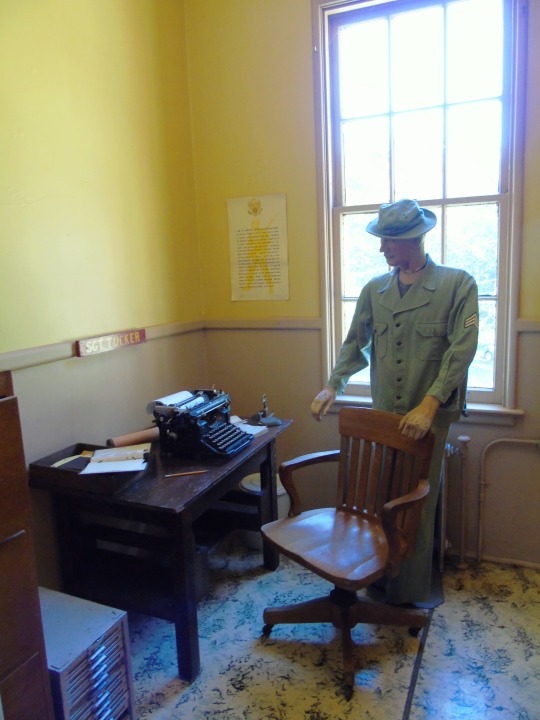


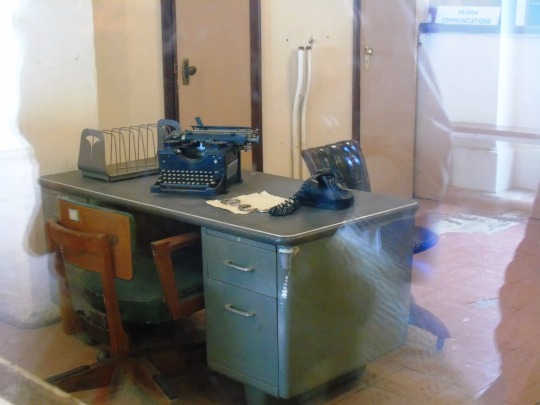
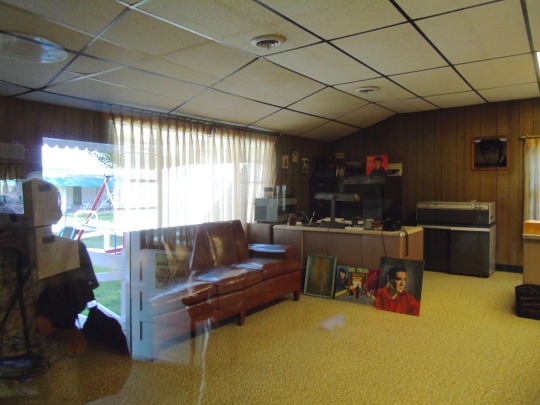

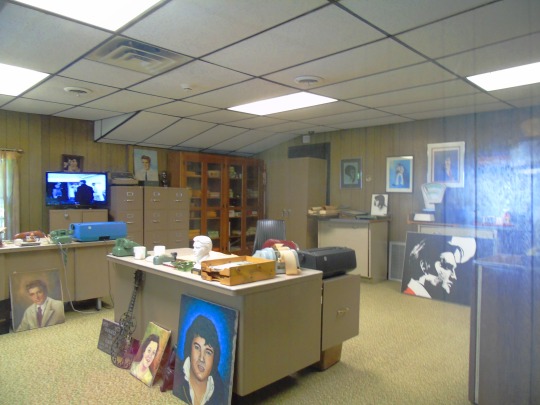
National Typewriter Day
National Typewriter Day is June 23 and we’re using the day to celebrate the written word! Typewriters have a strong history in not only the world but throughout the United States as well. Even though they might not be as popular as our trusty laptop companions, they’re a fun and niche way to exercise your brain.
History of National Typewriter Day
To many, typewriters are a remnant of the past. Truth be told, the patent for the first typewriter was not granted until 1829. Even then, the first typewriter as we know it today wasn’t built until 1867 near Milwaukee.
At their peak, typewriters were essential and sometimes the only way of typing books, articles, and manuscripts neatly. Although they fell out of vogue in the 20th century, the rise in hipster culture has made for a renewed popularity among young people.
Even now, many famous writers use typewriters to hone their creative processes. For instance, George R.R. Martin, Quintin Tarantino, and Jhumpa Lahiri are all well-known typewriter advocates.
Although the typewriter is well past its heyday in terms of necessity and interest, nowadays the restoration of typewriters is a niche yet successful industry. Just recently, a light blue Olivetti Lettera 32 sold for over $254,000. Now that’s something to write home about!
National Typewriter Day timeline
1575The Invention of ‘La Scrittura Tattile’
Italian printmaker Francesco Rampazetto invents ‘la scrittura tattile’ (the tactile writer) as a machine to quickly press letters into paper.
1843Charles Thurber Helps the Blind
American Charles Thurber invents a basic typing machine with the express aim of aiding the blind in communication.
1867The First Commercial Typewriter is Built
Christopher Latham Sholes and Carlos Glidden produce the first widely successful commercial typewriter near Milwaukee, Wisconsin.
21st centuryThe Typewriter’s Legacy
Although less popular, remnants of the typewriter, like the QWERTY keyboard and the term ‘backspace,’ still exist in modern life.
National Typewriter Day FAQs
How do typewriters work?
As paper is fed through a roller, the typist clacks a letter to have it dipped against the ink ribbon and onto the piece of paper. Just like a 26-piece stamp set!
Where can I buy a typewriter?
If you’re interested in a new hobby or in embellishing a writing habit, you can often find previously-loved typewriters in thrift stores and antique shops. For a cheaper one, check online.
Are typewriters still used professionally?
Many people who do not have access to consistent electricity use typewriters as a foolproof way to type. In a court setting, a stenographer uses a type of typewriter.
How to Celebrate National Typewriter Day
Find a typewriter
Read something
Write something
Typewriters can be found all over, from thrift stores to your grandparents’ attic. The act of finding one is a fun event in itself. Plus, if your family member has one stowed away, it can be a valuable bonding session between you two.
Even if physically having a typewriter isn’t an option, it’s still easy to celebrate. Pick up your favorite book, newspaper, or magazine and devote some time to reading it. Bonus points if your material was originally written with a typewriter!
Finally, take some time to write something. From a typewriter, to a computer, to a pencil, writing can be a soothing exercise that can help you flex your creative muscles. You could even have a friend over to write a story together.
5 Typewriter Facts To Discover Today
Ray Bradbury didn’t own a typewriter
Richard Brautigan loved them
Mark Twain was a trendsetter
Tom Hanks is a fanatic.
Ernest Hemingway was fidgety
In order to write his 1953 book “Fahrenheit 451,” Ray Bradbury used a typewriter rented from the library at UCLA.
Author Richard Brautigan says he thinks of entire stories in his head beforehand and then types them out all at once at almost 100 words per minute.
Mark Twain was the first author to showcase a typewritten book manuscript in “Life on the Mississippi,” published in 1883.
Actor Tom Hanks is an avid and well-known collector of old-school typewriters.
Ernest Hemingway was known to set his typewriter on a high bookshelf and write his stories standing up.
Why We Love National Typewriter Day
It’s easy to learn about history.
Writing brings people together
Typewriters are interesting
Because of their historical nature, typewriters are a wonderful gateway into the world of the past. And if you celebrate by simply reading, it’s easy to learn a thing or two from books.
At its core, writing brings people together from all backgrounds. Just imagine how many people have lost themselves in the same written world that you’re exploring right now!
When using a typewriter, you can’t help but be entranced by the intricacy of the machine in front of you. How exactly is it that all those moving parts and sounds create such amazing books?
Source
#Fort Columbia Historical State Park#Washington#California#San Francisco#Alcatraz Federal Penitentiary#United States Penitentiary Alcatraz Island#USA#summer 2017#Graceland#Memphis#Tennessee#2016#tourist attraction#landmark#interior#behind glass#National Typewriter Day#TypewritingDay#NationalTypewriterDay#23 June#vacation#travel
1 note
·
View note
Text
typing is so cool thanks Christopher Latham Sholes
1 note
·
View note
Text
Why Is The Keyboard Not In Alphabetic Order: Deciphering the Enigma

In this present reality, where letters in order are the building blocks of language, the game plan of letters on a keyboard appears to be a direct issue. Notwithstanding, the fact of the matter is nowhere near basic. Imagine assuming the keys were conveniently lined up in alphabetical order - it could appear to be intuitive, yet that is not the way keyboards are planned. Instead, we encounter a seemingly chaotic arrangement that has puzzled users for decades. So, why is the keyboard not in alphabetic order?
Hook: A Curious Conundrum
Have you ever paused to wonder why the letters on your keyboard are not in alphabetical order? It's a question that has crossed the minds of many typists, yet the answer lies in a labyrinth of historical developments and practical considerations.
Contextualization: A Journey Through Time
To comprehend the puzzle of non-alphabetical keyboard designs, we should travel back to the nineteenth century, a period of mechanical innovation and cultural change. It was during this period that the typewriter arose as a progressive device, offering a way to create composed text at uncommon paces.
Thesis Statement: Unveiling the Complexity
In this exploration, we will unravel the mysteries behind non-alphabetical keyboard layouts, focusing primarily on the iconic QWERTY arrangement. Through a top to bottom analysis of its origins, development, and contemporary difficulties, we expect to reveal insight into the intricate variables shaping our typing experience.So, buckle up as we embark on a journey through the annals of keyboard history, where logic and chaos intertwine to shape our digital interactions.
The Birth of QWERTY: A Revolution in Typing
The beginning of the typewriter time carried with it a pressing requirement for effectiveness and common sense. While the concept of mechanized writing promised to streamline communication, early models faced a significant obstacle – frequent mechanical jams caused by the rapid keystrokes of typists.
Historical Backdrop: Setting the Stage
In the late nineteenth hundred years, inventors and engineers were in a competition to foster a machine equipped for replicating human handwriting.The typewriter, with its mechanical keys and inked ribbons, emerged as the frontrunner in this technological pursuit.
Technical Constraints: Overcoming Challenges
Despite its potential, the early typewriter encountered a major setback – the tendency for adjacent keys to jam when pressed in quick succession. This issue, known as "key jamming," posed a formidable obstacle to the widespread adoption of typewriting technology.
Christopher Latham Sholes: The Architect of QWERTY
Enter Christopher Latham Sholes, a Wisconsin-based inventor and newspaper editor, who recognized the urgent need for a solution to the typewriter's jamming problem. Collaborating with fellow inventors Carlos Glidden and Samuel W. Soule, Sholes set out to design a keyboard layout that would minimize key clashes and maximize typing efficiency.
Deconstructing QWERTY: Logic Amidst Chaos
At first glance, the QWERTY layout may appear haphazard and arbitrary, but closer inspection reveals a carefully crafted design informed by practical considerations and ergonomic principles.
Layout Analysis: Deciphering the Pattern
The arrangement of keys on a QWERTY keyboard follows a distinct logic, with the most frequently used letters strategically positioned for optimal access. The top row, comprising the letters Q-W-E-R-T-Y, forms the foundation of the layout, serving as the anchor for subsequent key placements.
Ergonomic Considerations: Balancing Efficiency and Comfort
Despite its unconventional appearance, the QWERTY layout is surprisingly ergonomic, minimizing finger movement and reducing the risk of repetitive strain injuries. By dispersing commonly paired letters and prioritizing the placement of frequently used characters, the design aims to optimize typing speed and accuracy.
Historical Context: A Product of its Time
The enduring legacy of the QWERTY layout can be attributed to the historical context in which it emerged. During the late 19th century, efficiency and speed were paramount in the burgeoning field of typewriting, driving the adoption of innovative solutions like the QWERTY keyboard.
The Rise of Alternative Layouts: Challenging the Status Quo
While the QWERTY layout dominated the typewriter market for over a century, its reign has not been without challengers. Alternative keyboard layouts, designed to improve typing efficiency and ergonomic comfort, have emerged as contenders in the quest for the perfect typing experience.
Dvorak Simplified Keyboard: A Paradigm Shift
One of the most notable challengers to the QWERTY hegemony is the Dvorak Simplified Keyboard, developed in the 1930s by Dr. August Dvorak and his brother-in-law, Dr. William Dealey. Unlike the QWERTY layout, which prioritizes the placement of frequently used letters, the Dvorak layout is designed to minimize finger movement and maximize typing speed by concentrating the most commonly used keys on the home row.
Controversies and Debates: The Battle of Keyboards
Advocates of alternative layouts argue that designs like the Dvorak keyboard offer tangible benefits, including increased typing speed, reduced finger fatigue, and improved ergonomics. However, the entrenched familiarity of the QWERTY layout and the steep learning curve associated with switching to alternative layouts have hindered widespread adoption.
Adoption Barriers: Navigating Resistance
Despite the potential advantages of alternative keyboard layouts, their adoption remains limited due to a variety of factors. In addition to the challenges of retraining muscle memory and adjusting to new typing conventions, users must contend with the compatibility issues of alternative layouts with existing software and hardware systems. As a result, the QWERTY layout continues to maintain its dominance in the realm of typing interfaces.
The Modern Landscape: Navigating Diversity in Keyboard Layouts
In the digital age, technological advancements have expanded the possibilities for keyboard customization and adaptation. From programmable keyboards to niche layouts tailored to specific languages or typing styles, users now have more options than ever to personalize their typing experience.
Technological Advancements: Paving the Way for Innovation
The advent of programmable keyboards has empowered users to create custom layouts tailored to their unique preferences and typing habits. By allowing for the remapping of keys and the creation of macros, programmable keyboards offer unparalleled flexibility in optimizing the typing experience.
Niche Preferences: Catering to Diverse Needs
In addition to programmable keyboards, specialized layouts designed for specific languages or typing styles have gained traction among niche communities. Whether it's the Colemak layout for optimized English typing or the JCUKEN layout for Cyrillic languages, these niche layouts reflect the diverse linguistic and cultural landscapes of global typists.
Hybrid Solutions: Bridging Tradition and Innovation
Innovation in keyboard design is not limited to radical departures from established layouts like QWERTY or Dvorak. Instead, many users opt for hybrid solutions that combine the familiarity of traditional layouts with the customizable features of modern technology.
Conclusion: Why Is The Keyboard Not In Alphabetic Order
In conclusion, the arrangement of letters on a keyboard may seem like a trivial matter, but it is steeped in a rich history of innovation, practicality, and adaptation. From the humble origins of the typewriter to the digital age of programmable keyboards, the evolution of keyboard layouts reflects the ever-changing needs and preferences of typists around the world.
Throughout this exploration, we've traced the development of non-alphabetical keyboard layouts, focusing particularly on the iconic QWERTY arrangement and its challengers. From its inception as a solution to typewriter jams to its enduring legacy in the digital age, the QWERTY layout has stood the test of time, shaped by the imperatives of efficiency, comfort, and practicality.
While alternative layouts like the Dvorak keyboard offer compelling advantages in terms of typing speed and ergonomics, the widespread adoption of such designs remains a challenge. The entrenched familiarity of the QWERTY layout, coupled with compatibility concerns and the learning curve associated with switching to alternative layouts, has hindered significant progress in this regard.
As we look to the future, it's clear that the landscape of keyboard design will continue to evolve in response to technological advancements and shifting user preferences. Whether it's through programmable keyboards, niche layouts, or hybrid solutions, typists now have more options than ever to customize their typing experience to suit their individual needs.
In the end, the quest for the perfect keyboard layout is not just about efficiency or ergonomics – it's about striking a balance between tradition and innovation, comfort and functionality. As technology continues to advance and our understanding of human-computer interaction deepens, one thing remains certain: the keyboard, in all its variations, will remain a cornerstone of our digital lives for generations to come.
Read More: How To Setup A Wireless Keyboard: Step-by-Step Instructions
FAQs: Why Is The Keyboard Not In Alphabetic Order
Can you get a keyboard in alphabetical order? No, conventional keyboards are not organized in alphabetical order. The standard format, known as QWERTY, puts together letters in a particular example intended for productivity and reasonableness rather than alphabetical succession. Why is QWERTY the way it is? The QWERTY design, which has become the norm for typewriters and keyboards, was intended to address the mechanical constraints of early typewriters. Invented by Christopher Latham Sholes in the nineteenth hundred years, the QWERTY format disperses normally matched letters to forestall jamming and minimize typewriter breakdowns. Who decided the order of letters on a keyboard? The order of letters on a keyboard was determined by Christopher Latham Sholes, a paper manager and inventor who protected the main functional typewriter in 1868.
Read the full article
0 notes
Text
I'm not that type
The first practical typewriter was invented, attached to a sewing machine stand, back in September of 1867 thanks to Christopher Latham Sholes of Milwaukee. Remember when typing was a high school class? Yes you are old if you do. The last class was taught in 2011. Schools called it “keyboarding”.
The only thing I learned in school was when you got called by your full name…it meant big…

View On WordPress
#blog#boomer#class#education#history#invention#keyboard#learn#learning#memories#old#school#teacher#trouble#typewritier#typing
0 notes
Text
TUTTI FRUITY
◊ undisturbed Guillermo Mendana Olivera
◊ undisturbed Flora Stacey
◊ undisturbed Donovan
◊ undisturbed Henri Chopin
◊ undisturbed Morgan code
◊ undisturbed Bob Neill Persian
◊ undisturbed ART
◊ undisturbed Robert Morgan's Henri Chopin
◊ undisturbed John color
◊ undisturbed Bob Neill
◊ undisturbed Queen Elizabeth
◊ undisturbed Art History
◊ undisturbed Don
◊ undisturbed Hyuk Lee's
◊ undisturbed Art Gallery
◊ undisturbed Bob Roehrig's
◊ undisturbed 'Donovan' [email protected]
◊ undisturbed Miss Stacey
◊ undisturbed Christopher Latham Sholes
◊ undisturbed George Hutchison's
◊ undisturbed Art Typing
◊ undisturbed Joan G. Stark
◊ undisturbed Nathan Krevolin
◊ undisturbed John Foust
◊ undisturbed Ruth
0 notes
Text

The qwerty keyboard layout was designed in the 1870s by Christopher Latham Sholes. It is the oldest yet most popular keyboard layout.
visit: https://onlinetyping.org/
#typing#bestkeyboard#keyboard#OnlineTyping#touchtyping#typingtutor#learning#education#elearning#onlineeducation
0 notes
Text
Events 6.23
229 – Sun Quan proclaims himself emperor of Eastern Wu.
1266 – War of Saint Sabas: In the Battle of Trapani, the Venetians defeat a larger Genoese fleet, capturing all its ships.
1280 – The Spanish Reconquista: In the Battle of Moclín the Emirate of Granada ambush a superior pursuing force, killing most of them in a military disaster for the Kingdom of Castile.
1305 – A peace treaty between the Flemish and the French is signed at Athis-sur-Orge.
1314 – First War of Scottish Independence: The Battle of Bannockburn (south of Stirling) begins.
1532 – Henry VIII of England and Francis I of France sign the "Treaty of Closer Amity With France" (also known as the Pommeraye treaty), pledging mutual aid against Charles V, Holy Roman Emperor.
1565 – Dragut, commander of the Ottoman navy, dies during the Great Siege of Malta.
1594 – The Action of Faial, Azores. The Portuguese carrack Cinco Chagas, loaded with slaves and treasure, is attacked and sunk by English ships with only 13 survivors out of over 700 on board.
1611 – The mutinous crew of Henry Hudson's fourth voyage sets Henry, his son and seven loyal crew members adrift in an open boat in what is now Hudson Bay; they are never heard from again.
1683 – William Penn signs a friendship treaty with Lenni Lenape Indians in Pennsylvania.
1713 – The French residents of Acadia are given one year to declare allegiance to Britain or leave Nova Scotia, Canada.
1757 – Battle of Plassey: Three thousand British troops under Robert Clive defeat a 50,000-strong Indian army under Siraj ud-Daulah at Plassey.
1758 – Seven Years' War: Battle of Krefeld: British, Hanoverian, and Prussian forces defeat French troops at Krefeld in Germany.
1760 – Seven Years' War: Battle of Landeshut: Austria defeats Prussia.
1780 – American Revolution: Battle of Springfield fought in and around Springfield, New Jersey (including Short Hills, formerly of Springfield, now of Millburn Township).
1794 – Empress Catherine II of Russia grants Jews permission to settle in Kyiv.
1810 – John Jacob Astor forms the Pacific Fur Company.
1812 – War of 1812: Great Britain revokes the restrictions on American commerce, thus eliminating one of the chief reasons for going to war.
1860 – The United States Congress establishes the Government Printing Office.
1865 – American Civil War: At Fort Towson in the Oklahoma Territory, Confederate Brigadier General Stand Watie surrenders the last significant Confederate army.
1868 – Christopher Latham Sholes received a patent for an invention he called the "Type-Writer".
1887 – The Rocky Mountains Park Act becomes law in Canada creating the nation's first national park, Banff National Park.
1894 – The International Olympic Committee is founded at the Sorbonne in Paris, at the initiative of Baron Pierre de Coubertin.
1913 – Second Balkan War: The Greeks defeat the Bulgarians in the Battle of Doiran.
1914 – Mexican Revolution: Pancho Villa takes Zacatecas from Victoriano Huerta.
1917 – In a game against the Washington Senators, Boston Red Sox pitcher Ernie Shore retires 26 batters in a row after replacing Babe Ruth, who had been ejected for punching the umpire.
1919 – Estonian War of Independence: The decisive defeat of the Baltische Landeswehr in the Battle of Cēsis; this date is celebrated as Victory Day in Estonia.
1926 – The College Board administers the first SAT exam.
1931 – Wiley Post and Harold Gatty take off from Roosevelt Field, Long Island in an attempt to circumnavigate the world in a single-engine plane.
1938 – The Civil Aeronautics Act is signed into law, forming the Civil Aeronautics Authority in the United States.
1940 – Adolf Hitler goes on a three-hour tour of the architecture of Paris with architect Albert Speer and sculptor Arno Breker in his only visit to the city.
1940 – Henry Larsen begins the first successful west-to-east navigation of Northwest Passage from Vancouver, British Columbia, Canada.
1941 – The Lithuanian Activist Front declares independence from the Soviet Union and forms the Provisional Government of Lithuania; it lasts only briefly as the Nazis will occupy Lithuania a few weeks later.
1942 – World War II: Germany's latest fighter aircraft, a Focke-Wulf Fw 190, is captured intact when it mistakenly lands at RAF Pembrey in Wales.
1946 – The 1946 Vancouver Island earthquake strikes Vancouver Island, British Columbia, Canada.
1947 – The United States Senate follows the United States House of Representatives in overriding U.S. President Harry S. Truman's veto of the Taft–Hartley Act.
1951 – The ocean liner SS United States is christened and launched.
1956 – The French National Assembly takes the first step in creating the French Community by passing the Loi Cadre, transferring a number of powers from Paris to elected territorial governments in French West Africa.
1959 – Convicted Manhattan Project spy Klaus Fuchs is released after only nine years in prison and allowed to emigrate to Dresden, East Germany where he resumes a scientific career.
1960 – The United States Food and Drug Administration declares Enovid to be the first officially approved combined oral contraceptive pill in the world.
1961 – The Antarctic Treaty System, which sets aside Antarctica as a scientific preserve and limits military activity on the continent, its islands and ice shelves, comes into force.
1967 – Cold War: U.S. President Lyndon B. Johnson meets with Soviet Premier Alexei Kosygin in Glassboro, New Jersey for the three-day Glassboro Summit Conference.
1969 – Warren E. Burger is sworn in as Chief Justice of the United States Supreme Court by retiring Chief Justice Earl Warren.
1969 – IBM announces that effective January 1970 it will price its software and services separately from hardware thus creating the modern software industry.
1972 – Watergate scandal: U.S. President Richard M. Nixon and White House Chief of Staff H. R. Haldeman are taped talking about illegally using the Central Intelligence Agency to obstruct the Federal Bureau of Investigation's investigation into the Watergate break-ins.
1972 – Title IX of the United States Civil Rights Act of 1964 is amended to prohibit sexual discrimination to any educational program receiving federal funds.
1973 – A fire at a house in Hull, England, which kills a six-year-old boy is passed off as an accident; it later emerges as the first of 26 deaths by fire caused over the next seven years by serial arsonist Peter Dinsdale.
1985 – A terrorist bomb explodes at Narita International Airport near Tokyo. An hour later, the same group detonates a second bomb aboard Air India Flight 182, bringing the Boeing 747 down off the coast of Ireland killing all 329 aboard.
1991 – Sonic the Hedgehog is released in North America on the Sega Genesis platform, beginning the popular video game franchise.
1994 – NASA's Space Station Processing Facility, a new state-of-the-art manufacturing building for the International Space Station, officially opens at Kennedy Space Center.
2001 – The 8.4 Mw southern Peru earthquake shakes coastal Peru with a maximum Mercalli intensity of VIII (Severe). A destructive tsunami followed, leaving at least 74 people dead, and 2,687 injured.
2012 – Ashton Eaton breaks the decathlon world record at the United States Olympic Trials.
2013 – Nik Wallenda becomes the first man to successfully walk across the Grand Canyon on a tight rope.
2013 – Militants storm a high-altitude mountaineering base camp near Nanga Parbat in Gilgit–Baltistan, Pakistan, killing ten climbers and a local guide.
2014 – The last of Syria's declared chemical weapons are shipped out for destruction.
2016 – The United Kingdom votes in a referendum to leave the European Union, by 52% to 48%.
2017 – A series of terrorist attacks take place in Pakistan, resulting in 96 deaths and wounding 200 others.
2018 – Twelve boys and an assistant coach from a soccer team in Thailand are trapped in a flooding cave, leading to an 18-day rescue operation.
0 notes
Text
Efemérides literarias: 23 de junio
Acontecimientos
1868: Christopher Latham Sholes recibe la patente de la primera máquina de escribir.
Nacimientos
1805: Manuel Ascencio Segura, escritor peruano (f. 1871).
1841: Benoît Malon, escritor anarquista francés (f. 1893).
1860: José María Vargas Vila, escritor colombiano (f. 1933).
1875: Carl Milles, escultor sueco (f. 1955).
1922: Juan San Martín, escritor español (f.…

View On WordPress
0 notes
Text
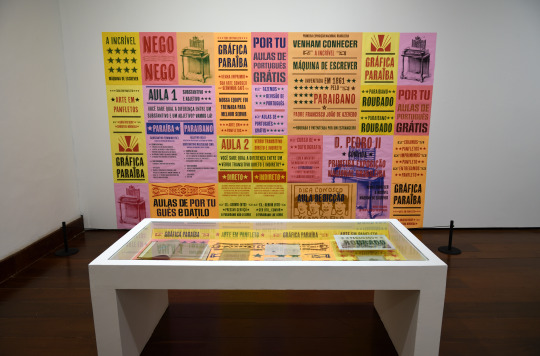
Christus Nóbrega. Gráfica Paraíba, Arte em Panfleto. 2021-2022. Instalação composta por cartazes, panfletagem, bandeiras e livros dimensões variadas. Divulgação
Sou um artista paraibano interessado nas relações entre lugar e memória. Assim, parto de duas dessas vinculações para construir esse trabalho. A primeira é o curioso modo como a palavra Paraíba é utilizada no território do Rio de Janeiro. Paraíba, gramaticalmente caracterizada como substantivo próprio feminino, é subvertida coloquialmente em adjetivo masculino “o paraíba”, corrompendo além do estatuto da língua portuguesa, o próprio estatuto de quem por ela é nomeado. Ao tirar a grandeza da inicial maiúscula que lhe é devida por direito gramatical e civil (P por p), e acrescentando-lhe um artigo de gênero que não é o seu (a por o), cometem crime linguístico e crime de injúria.
A modal subversão linguística esconde violências, apagamento e perversões de estratificação social. Violências que faz emergir o segundo fator estruturante deste trabalho – o roubo do invento da máquina de escrever criada pelo paraibano, Pe. Francisco João de Azevedo. Apresentada ao Rio de Janeiro durante a Primeira Exposição Nacional em 1861, a máquina foi um dos nove inventos premiados com uma medalha de ouro entre os 1.136 participantes. Porém, após sucessivas rejeições de apoio para industrialização, o inventor foi dissuadido a deixar levarem o protótipo para o exterior com a promessa de que havia pessoas interessadas em fabricá-lo. Anos depois, Christopher Latham Sholes apresentou como seu um modelo praticamente idêntico à máquina paraibana para a empresa Remington, que o industrializaram.
Christus Nóbrega. Artista plástico, seus trabalhos investigam as relações entre lugar, memória, corpo e ficção, recorrendo à poética da alteridade e a métodos da viagem e da residência artística. Dentre suas exposições individuais mais recentes destacam-se Dragão, Floresta, Abundante (25a Bienal de Curitiba, 2018; CCBB, Belo Horizonte, 2018 e CCBB, Brasília, 2017) e Labirinto (CCAS, Canberra, 2019; Artisan, Queensland, 2018 e Palácio das Artes, Belo Horizonte, 2017). Vem apresentando sua obra em mostras coletivas em diversos espaços brasileiros a exemplo do Museu Nacional da República (Brasília), Centro Cultural Correios (Brasília e São Paulo), Caixa Cultural (Rio de Janeiro), MAR (Rio de Janeiro) e Estação das Artes (João Pessoa). Integra em acervos e coleções particulares e institucionais a exemplo da Fondation Cartier (Paris), MAR e Museu Nacional da República (Brasília). Recebeu os prêmios Petrobras Cultural (2005 e 2009), Programa de Residência Artística do Ministério das Relações Exteriores do Brasil (2015 e 2018), Programa de Patrocínio do Centro Cultural Banco do Brasil (2017). Foi indicado para o Prêmio Investidor Profissional de Arte (Pipa, 2017 e 2019). Graduou-se em design pela Universidade Federal da Paraíba (UFPB). É mestre e doutor em arte pela Universidade de Brasília (UnB). É pesquisador e professor da UnB. Representou o Brasil na China (2015) e na Austrália (2018) pelo Programa de Residência Artística do Ministério das Relações Exteriores do Brasil.
🔗 Esta obra integra a exposição coletiva “Espaços do Ainda”, em cartaz de 1. de julho a 13 de agosto de 2023 no Centro Cultural São Paulo - CCSP, São Paulo, SP. Acesse mais informações aqui:
0 notes
Text
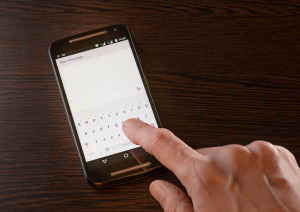
Also known as Sholes keyboards, QWERTY keyboards refer to the five consecutive letters in the upper left corner of the keyboard. This type of keyboard has the layout used for Latin languages and is the most commonly used keyboard in the United States.
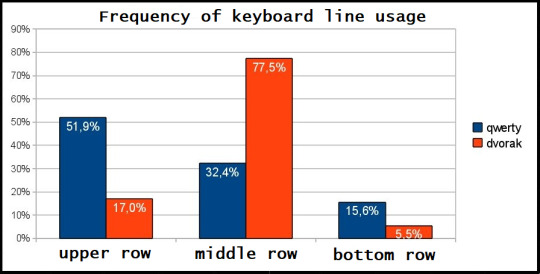
This PC keyboard is based on the design of the first typewriters. Until the late 19th century, typewriter keys were arranged in alphabetical order. In 1872, Christopher Latham Sholes (1819-1890) developed the first typewriter, which featured the QWERTY keyboard, so named because the first six letters near the top left of the keyboard are Q-W-E-R-T-Y.
The original keyboard key layout was two rows in alphabetical order. Well, the layout is such that the writing strips of the most commonly used monograms are all next to each other, so that the keys get stuck when tapped quickly one after the other.
Attempts to solve this flaw resulted in a rearrangement of the keys. In 1868, Sholes teamed up with educator Amos Densmore in order to arrange the letters on keyboards to allow better spacing between commonly used keys used in combination. As a result, this initially made it difficult for people to find the letters they needed to type efficiently. The new layout was designed to improve typing speed, and place keys less likely to be struck in rapid succession on opposite sides of the typewriter. This was done so that the machine would be less likely to jam.
The arrangement solved the interference problem, but created two others. First, many common letters are not located in the centre row, also called the "home row." Second, some of the most common letters are concentrated on the left side, favouring left-handed typists. For example, the most common letter, "E", is a stretch for the left middle finger, and the second most common letter, "A", is typed with the weaker finger of the left hand.
0 notes
Text
Is QWERTY Keyboard best?
QWERTY
For the story of Qwerty keyboards, we will have to go back 150 years to late 1880 when one Mr. Christopher Latham Sholes was tinkering in his lab in Milwaukee to develop the prototype for typewriters.
Now the legend has that the Sholes was trying to develop a layout such the expensive typewriting machines won’t get jammed. There is no conclusive evidence to suggest that this was the case…
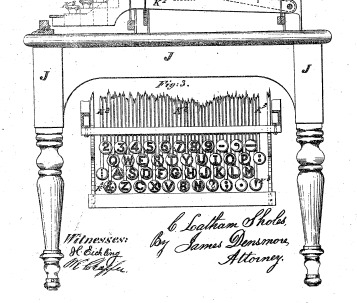
View On WordPress
0 notes
Text
Ejercicio 2
El teléfono
Antonio Meucci
Era el 1854, y por necesidad, inventó el telettrófoni. Con la intención de comunicarse desde su oficina hasta la habitación de su esposa enferma, pero al ser pobre no tenía el recurso suficiente para patentar el invento.

Johann Philipp Reis
En 1863, utilizó el termino telephon para referirse a una membrana vibradora que emitía sonidos musicales.
Alexander Graham Bell y Elias Gray
Científicos que, en 1876, fueron a la Oficina de Patentes de Nueva York a registrar su invento: el teléfono; sin embargo, por llegar temprano solo se reconoció a Graham Bell como el padre del teléfono por ser el primero en patentar el dispositivo.
No después de 20 años todos tenían un teléfono por la gran demanda y oportunidad de poder comunicarse con las personas de cualquier parte del estado que tenga otro teléfono.
Los primeros teléfonos eran fijos y necesitaban de una manivela y estar conectados a electricidad para su funcionamiento, para poder hacer una llamada todo se conectaba por una operadora para que se puedan comunicar los interlocutores.
En 1884 llegaron los teléfonos de disco rotatorio (un modelo que se ha visto en las caricaturas) y con este modelo se llegó la oportunidad de hacer llamadas sin tener operadores detrás de la llamada de larga distancia (entre Nueva York y Boston).
Cinco años después llegaron los teléfonos públicos que con monedas podías hacer tus llamadas hasta que en 1897, con la invención de la radio empezó también el de los teléfonos que hoy en día conocemos.

1973, Martin Cooper es conocido como el padre del teléfono móvil y fue el primer hombre en hacer una llamada sin cables, los años posteriores se crearon más modelos del teléfono móvil con una durabilidad máxima de 30 minutos de llamada.
En la década de los 90´s ya había una variedad de marcas, los diseños eran más sólido, tenia tapa y agregaron pantalla a color, pero no fue hasta el siglo actual en la que adicionaron la cámara para poder tomar fotos y por el 2007 ya se podía mandar mensajes de texto y multimedia.
En el 2007 Steve Jobs anuncio una nueva versión del teléfono móvil con nuevas tecnologías en el primer modelo, actualmente popular, de iPhone.
Le añadieron pantalla táctil, navegación por internet y aplicaciones demás de servicio, haciéndolo multifuncional.
Actualmente en el mercado de la tecnología existen muchas marcas de teléfonos móviles con más innovaciones hasta incluso en los relojes de muñeca.

Maquina de escribir
Henry Mill
Gran Bretaña,1714.
Es el primer posible registro de la máquina de escribir, buscaba patentar un método para la impresión o transcripción de letras, pero de ahí no hay más información.
La primera máquina de escribir comprobada fue construida por Pellegrino Turri (Italia) en 1808 para su amiga ciega, pero no se tiene registro alguno más que las cartas de ella.
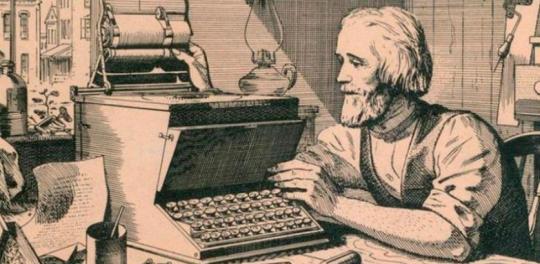
Fue entonces que, al francés Xavier Progin le fue dada la patente en 1833, incorporó el uso de cada letra o símbolo, de líneas de linotipia separadas y accionadas por palancas separadas.
El mecanismo para mover el papel entre caracteres y entre líneas es en casi todas las máquinas de escribir modernas un rodillo cilíndrico que sujeta el papel y se mueve horizontalmente para dejar espacio entre las líneas.
La primera máquina que utilizo este método fue en 1843 por Charles Grover Thurber. Tenia agregado un anillo de metal al rodillo, la máquina funcionaba girando el anillo hasta que la letra de centre sobre la posición de impresión en rodillo y luego oprimía la tecla.

En 1870 se comenzó a vender un modelo por Rasmus Malling-Hansen llamado ‘Skrivekügel’, tenia un diseño en forma de bola que permitía la escritura, sin embargo, el usuario no podía ver el resultado hasta terminar.
El impresor Christopher Latham Sholes, al mismo tiempo de la entrada de la ‘Skrivekügel’, creo un modelo similar a la maquina de escribir que conocemos hoy en día.
En 1873 una empresa fabricante de armas, equipos agrícolas y máquinas de coser comenzó a comercializar una serie que ganó mucha demanda por parte del publico.
En el año 1895 ya existía una profesión que de dedicaba a la máquina de escribir: los mecanógrafos (la cual se volvió muy popular entre las mujeres tras la similitud entre la máquina de coser y escribir), y una de las mejoras más destacadas era que el escritor ya podía ver lo que ponía.
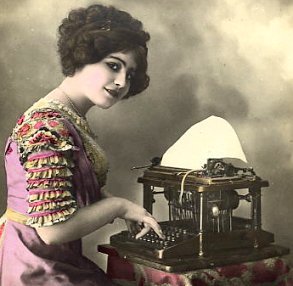
Las máquinas de escribir, en 1920, ya se habían adaptado no solo en oficinas, sino que entró también en el cine; periodismo; teatro, literatura y cualquier tipo de actividad que contenga la escritura, haciéndolas más famosas en el mundo.
Sin embargo, en 1940 habían sacado una máquina de escribir con teclas silenciosas y sin timbre al final de cada línea, pero al ya tener a los usuarios acostumbrados al sonido de estas cada que se escribe y el timbre, así que fue un fracaso total.

Thomas Alva Edison, en 1870, desarrolló el concepto de máquina de escribir eléctrica. Pero la primera máquina operativa electrónica fue fabricada en Blickensdefer Manifacturing Company, de Standford, en 1902.
Después de un tiempo la máquina de escribir tuvo su versión electrónica, en ella el usuario podía ver a través de una pantalla lo que se escribía y poder corregir y así poder imprimir correctamente. De ahí llegaron los procesadores de texto con una memoria interna y capacidad de almacenar información del texto en cartuchos o disquetes.
1 note
·
View note
Photo

Christopher Latham Sholes was born on February 14, 1819. He was an American inventor who invented the QWERTY keyboard, and, along with Samuel W. Soule, Carlos Glidden and John Pratt, has been contended to be one of the inventors of the first typewriter in the United States. He was also a newspaper publisher and Wisconsin politician.
Typewriters with various keyboards had been invented as early as 1714 by Henry Mill and have been reinvented in various forms throughout the 1800s. It is believed that Sholes drew inspiration from the inventions of others, including those of Frank Haven Hall, Samuel W. Soule, Carlos Glidden, Giuseppe Ravizza and, in particular, John Pratt, whose mention in an 1867 Scientific American article Glidden is known to have shown Sholes. Sholes' typewriter improved on both the simplicity and efficiency of previous models, which led to his successful patent and commercial success.
Sholes had moved to Milwaukee and became the editor of a newspaper. Following a strike by compositors at his printing press, he tried building a machine for typesetting, but this was a failure and he quickly abandoned the idea. He arrived at the typewriter through a different route. His initial goal was to create a machine to number pages of a book, tickets and so on. He began work on this at a machine shop in Milwaukee, together with a fellow printer Samuel W. Soule They patented a numbering machine on November 13, 1866.
Sholes and Soule showed their machine to Carlos Glidden, a lawyer and amateur inventor at the machine shop who was working on a mechanical plow. Glidden wondered if the machine could not be made to produce letters and words as well. Further inspiration came in July 1867, when Sholes came across a short note in Scientific American describing the "Pterotype", a prototype typewriter that had been invented by John Pratt. From the description, Sholes decided that the Pterotype was too complex and set out to make his own machine, whose name he got from the article: the typewriting machine, or typewriter.
For this project, Soule was again enlisted and Glidden joined them as a third partner to provide funding. The Scientific American article (unillustrated) had figuratively used the phrase "literary piano"; the first model that the trio built had a keyboard literally resembling a piano. It had black keys and white keys, laid out in two rows. It did not contain keys for the numerals 0 or 1 because the letters O and I were deemed sufficient:
3 5 7 9 N O P Q R S T U V W X Y Z 2 4 6 8 . A B C D E F G H I J K L M
The first row was made of ivory and the second of ebony, the rest of the framework was wooden. Despite the evident prior art by Pratt, it was in this same form that Sholes, Glidden and Soule were granted patents for their invention on June 23, 1868 and July 14. The first document to be produced on a typewriter was a contract that Sholes had written, in his capacity as the comptroller for the city of Milwaukee. Machines similar to Sholes's had been previously used by the blind for embossing, but by Sholes's time the inked ribbon had been invented, which made typewriting in its current form possible.
At this stage, the Sholes-Glidden-Soule typewriter was only one among dozens of similar inventions. They wrote hundreds of letters on their machine to various people, one of whom was James Densmore of Meadville, Pennsylvania. Densmore believed that the typewriter would be highly profitable, and offered to buy a share of the patent, without even having seen the machine. The trio immediately sold him one-fourth of the patent in return for his paying all their expenses so far. When Densmore eventually examined the machine in March 1867, he declared that it was good for nothing in its current form, and urged them to start improving it. Discouraged, Soule and Glidden left the project, leaving Sholes and Densmore in sole possession of the patent.
Realizing that stenographers would be among the first and most important users of the machine, and therefore best in a position to judge its suitability, they sent experimental versions to a few stenographers. The most important of them was James O. Clephane of Washington D.C., who tried the instruments as no one else had tried them, subjecting them to such unsparing tests that he destroyed them, one after another, as fast as they could be made and sent to him. His judgments were similarly caustic, causing Sholes to lose his patience and temper. But Densmore insisted that this was exactly what they needed:
This candid fault-finding is just what we need. We had better have it now than after we begin manufacturing. Where Clephane points out a weak lever or rod let us make it strong. Where a spacer or an inker works stiffly, let us make it work smoothly. Then, depend upon Clephane for all the praise we deserve.
Sholes took this advice and set to improve the machine at every iteration, until they were satisfied that Clephane had taught them everything he could. By this time, they had manufactured 50 machines or so, at an average cost of $250 (equivalent to almost $5,000 in 2020). They decided to have the machine examined by an expert mechanic, who directed them to E. Remington and Sons (which later became the Remington Arms Company), manufacturers of firearms, sewing machines and farm tools. In early 1873, they approached Remington, who decided to buy the patent from them. Sholes sold his half for $12,000, while Densmore, still a stronger believer in the machine, insisted on a royalty, which would eventually fetch him $1.5 million.
Sholes returned to Milwaukee and continued to work on new improvements for the typewriter throughout the 1870s, which included the QWERTY keyboard (1873). James Densmore had suggested splitting up commonly used letter combinations in order to solve a jamming problem caused by the slow method of recovering from a keystroke: weights, not springs, returned all parts to the "rest" position. This concept was later refined by Sholes and the resulting QWERTY layout is still used today on both typewriters and English language computer keyboards, although the jamming problem no longer exists.
Sholes died on February 17, 1890, after battling tuberculosis for nine years. He is buried at Forest Home Cemetery in Milwaukee.
Daily inspiration. Discover more photos at http://justforbooks.tumblr.com
13 notes
·
View notes
Photo
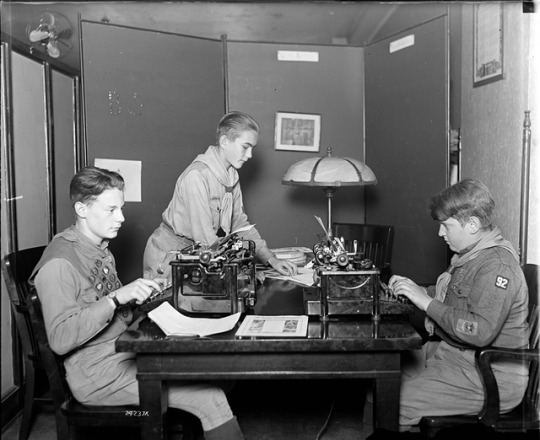


Typewriter Tuesday!
According to the Wisconsin Historical Society, today in 1878 is the day that inventor Christopher Latham Sholes patented the commercial typewriter. Sholes worked with Carlos Glidden and Samuel Soulé in Kleinsteuber’s Machine Shop in Milwaukee during the late 1860s to create a prototype. The patent was later sold to Remington Arms Company.
These scouts seem a little less than enthusiastic about this technology.
This is an image of a photograph taken by James Blair Murdoch in October 1929. It is part of the James Blair Murdoch Photographs digital collection (UWM Mss 131).
#uwm archives#typewriters#typewriter tuesday#scouts#boy scouts of america#milwaukee history#James Blair Murdoch#1920s#vintage photography#vintage typewriter#wisconsin#wisconsin history#christopher latham sholes#archives#digital collections
19 notes
·
View notes